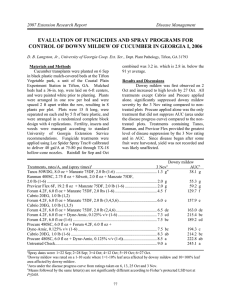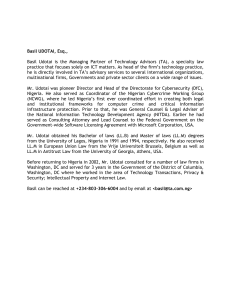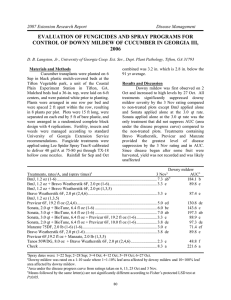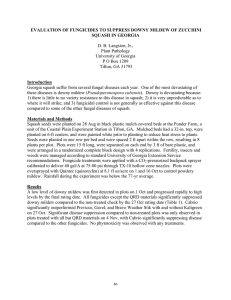Greenhouse TPM/IPM Report March 28, 2014
advertisement
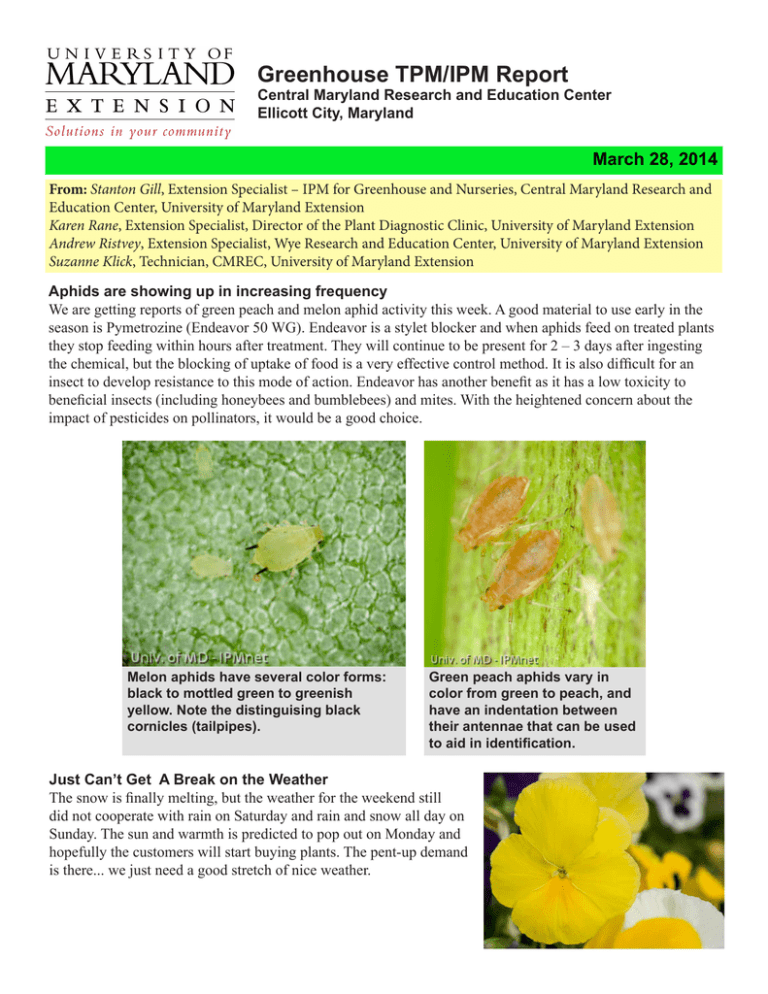
Greenhouse TPM/IPM Report Central Maryland Research and Education Center Ellicott City, Maryland March 28, 2014 From: Stanton Gill, Extension Specialist – IPM for Greenhouse and Nurseries, Central Maryland Research and Education Center, University of Maryland Extension Karen Rane, Extension Specialist, Director of the Plant Diagnostic Clinic, University of Maryland Extension Andrew Ristvey, Extension Specialist, Wye Research and Education Center, University of Maryland Extension Suzanne Klick, Technician, CMREC, University of Maryland Extension Aphids are showing up in increasing frequency We are getting reports of green peach and melon aphid activity this week. A good material to use early in the season is Pymetrozine (Endeavor 50 WG). Endeavor is a stylet blocker and when aphids feed on treated plants they stop feeding within hours after treatment. They will continue to be present for 2 – 3 days after ingesting the chemical, but the blocking of uptake of food is a very effective control method. It is also difficult for an insect to develop resistance to this mode of action. Endeavor has another benefit as it has a low toxicity to beneficial insects (including honeybees and bumblebees) and mites. With the heightened concern about the impact of pesticides on pollinators, it would be a good choice. Melon aphids have several color forms: black to mottled green to greenish yellow. Note the distinguising black cornicles (tailpipes). Green peach aphids vary in color from green to peach, and have an indentation between their antennae that can be used to aid in identification. Just Can’t Get A Break on the Weather The snow is finally melting, but the weather for the weekend still did not cooperate with rain on Saturday and rain and snow all day on Sunday. The sun and warmth is predicted to pop out on Monday and hopefully the customers will start buying plants. The pent-up demand is there... we just need a good stretch of nice weather. What About Basil Plants? The last couple of years have not been good for basil plants, at least disease wise. Downy mildew has been a major factor in taking this valuable greenhouse plant down. This is a very serious disease that is inflicting major losses in basil crops. We all know basil is a major money crop for greenhouse operations. Last Tuesday (March 25th) we held a conference on invasive species in Maryland and Dr. Yazmin Rivera, who is a visiting USDAARS scientist and post doctoral researcher at Rutgers University, gave growers the low-down on the downy mildew problem associated with basil plants. Upper surface of basil leaf infected with downy mildew showing symtpoms of yellowing between major veins. David Clement, HGIC Lower surface of basil leaf infected with downy mildew showing grayish spores of the pathogen. Photo: David Clement, HGIC This disease was first detected in Florida back in 2007. Since then it has been found in many states including Maryland. Growers generally did not realize their basil had a disease because the most noticeable symptom on infected plants was yellowing resembling a nutritional deficiency. The pathogen (Peronospora belbahrii) can be seed-borne, as well as dispersed via air-borne spores. One way or another it arrived in America and has been aggressively spreading around to greenhouse operations throughout the country. Unfortunately, all sweet basil varieties evaluated have been found to be very susceptible. Other basil types, such as lemon basil and red-leafed varieties, are generally less affected by the disease. Yasmin pointed out that downy mildew found on coleus and salvia were thought, at first, to be the same downy mildew pathogen since these plants are in the same family, Lamiaceae. Further research has demonstrated that the downy mildew found on salvia and coleus are genetically different. You don’t have to worry that salvia or coleus plants are reservoirs for downy mildew that strikes basil. Yasmin’s advice on how to deal with downy mildew is to first learn the symptoms. Observing spores on the underside of leaves is key to diagnosis. Spores are produced during dark, cloudy periods or at night, therefore early morning is the best time to inspect basil for downy mildew. She suggested that leaves with yellowing resembling downy mildew but lacking spores can be placed upside down on wet paper towel in a closed plastic bag in the dark for a day to encourage the pathogen to produce spores. Minimizing leaf wetness and reducing humidity to obtain conditions unfavorable for disease development may suppress downy mildew, especially in greenhouses. Keep the HAF fans going and keep the air moving around the plants the best you can. Increased plant spacing can also help with air circulation and reducing humidity. For conventional basil production, there are several phosphorous acid (phosphanate) fungicides labeled for this disease, including ProPhyt, Fosphite, Fungi-Phite and K-Phite. Ranman (cyazofamid) has been evaluated at Cornell University and been found to be very effective on downy mildew on basil. These products are labelled for use in greenhouses. For organic basil production, OMRI-listed products for suppressing foliar diseases on herbs, including downy mildew, include Actinovate AG (Streptomyces lydicus), MilStop (potassium bicarbonate), Regalia (extract of Reynoutria sachalinensis), Trilogy (neem oil), and OxiDate (hydrogen dioxide). MilStop, Regalia, and OxiDate are labeled for both outdoor and greenhouse use. Dr. Meg McGrath at Cornell University’s Long Island Research Center has been participating in a basil downy mildew monitoring program since 2009, and maintains an informational web site with photos and up-to-date information on variety trials and labelled fungicides. In addition, you can report your sightings of the disease and be part of the monitoring study. Dr. McGrath’s website can be found at the following link: http://vegetablemdonline.ppath.cornell.edu/NewsArticles/BasilDowny.html Tobacco Mosaic Virus Last week, we received images of petunias infected with tobacco mosaic virus (TMV). The plants did not show symptoms in the vegetative stages of the plant development and the grower left them in the greenhouse. As the plants have come into flower the streaking symptoms are clearly seen on the flower petals. Obviously, these plants need to be disposed of properly using protective gloves and coveralls. Use precaution not to spread it to other plants. Streaking on petunia flowers caused by tobacco mosaic virus. European Pepper Moth (EPM) Growers have been putting out the pheromone traps (lures are available from Koppert Biological Systems, 800-928-8827) for the European pepper moth, Duponchelia fovealis, over the last few weeks. One grower has already found two adults in a trap on March 20. The eggs are laid on foliage and hatching larvae initially feed on lower leaves near soil level, making round or crescent shaped holes. This damage can be monitored visually in an IPM scouting program. Older larvae consume whole leaves or they can feed on roots or at the base of the plant at soil level. In some cases they girdle the base of a plant. Later instar larvae burrow into soft woody or herbaceous stems causing damage in which fungi can enter. As the larvae prepare to pupate they web silk together usually on foliage close to the soil. Removing debris and lower leaves will reduce habitat for the larvae. Repeated sprays of Bacillus thuringiensis can be directed to foliage to kill larvae feeding on the foliage. Spinosad materials should also be effective in controlling the caterpillars. Acephate in preliminary trials has been shown to be one of the more effective materials for control. More details on the European pepper moth are available at http://www.extension.umd.edu/learn/greenhouse-ipm-pest-alert-european-pepper-moth Sclerotinia on Petunia We received a report that sclerotinia is infecting petunia plants on the Eastern Shore. The current cold, wet conditions are ideal for this disease. Symptoms of sclerotinia include crown rot, stem rot, and flower blight. Under humid conditions, fluffly white fungal growth develops on infeced plant parts which gives this disease the name ‘white mold’. Sclerotia (hard, black structures) are very resistant to environmental extremes, and can survive in soil and plant debris for several years. Sanitation is critical for managing this disease. Do not use unsterilized field soil in potting mixes. Avoid introducing untreated field soil to the greenhouse on tools or equipment, and keep weeds under control. Discard infected plants promptly. Fungicide drenches can help protect plants from infection. Operator Certification (FTC) for Writing Nursery Nutrient Management Plans on April 9th, 2014 Central Maryland Research and Education Center, 11975-A Homewood Road, Ellicott City, MD 21042 Nursery Operator Certification (FTC) for writing nursery nutrient management plans will be offered to growers who are interested in attaining Farmer Training Certification for writing nutrient management plans. This training will assist you in writing a nutrient management plan for your nursery or greenhouse operation. You must write a plan if you use fertilizers and you gross $2500 of over per year in sales. With this certification, you will be able to sign-off and submit your own plan and annual implementation reports. Each program consists of a Training Day (plan writing process) and an Exam/Signoff Day. After the Training Day you have about 5 weeks to study the Nursery Nutrient Management Training Manual and develop your plan. The Exam/ Signoff Day will be for taking the exam and going over your newly developed plan (or renewing your old plan). The process is relatively simple for small (low-risk) operations, so if your operation size is less than 5 acres, we strongly encourage you to think about becoming a certified operator. If your operation is larger than 5 acres, we still encourage you to become a certified operator even though the nutrient management process may be a little more complicated. Drs. John Lea-Cox and Andrew Ristvey will be happy to help you write your nutrient management plan. The training day will be April 9, 2014 at Central MD Research and Ed. Ctr (CMREC). We have tentatively scheduled the Exam/Signoff Day for May 12th at Maryland Department of Agriculture in Annapolis, MD (day may change to the 13th or 14th depending on attendee’s schedules). After passing the exam, you will be able to “sign off” on your plan and submit it. To express your interest in taking this training, please contact Mike Webster, Maryland Department of Agriculture at (410) 841-5957. State that it is for Nursery FTC. Call Andrew Ristvey (410) 827-8056 x113 for directions to CMREC or for any other questions. Upcoming Programs Go to http://www.extension.umd.edu/ipm/conferences MGGA Field Day June 19, 2014 (afternoon through early evening) Location: Tidal Creek Growers, Davidsonville, MD Greenhouse Biocontrol Conference August 6, 2014 Location: Maritime Institute, Linthicum, MD Stormwater Management Program August 20 and 21, 2014 TWO Locations: August 20 - Montgomery County Extension Office, Derwood, MD August 21 - Robinson Nature Center, Columbia, MD Details will be posted when available The information given herein is supplied with the understanding that no discrimination is intended and no endorsement by University of Maryland Extension is implied. Read labels carefully before applying any pesticides. Photographs are by Suzanne Klick and Stanton Gill unless stated otherwise. The University of Maryland Extension programs are open to any person and will not discriminate against anyone because of race, age, sex, color, sexual orientation, physical or mental disability, religion, ancestry, national origin, marital status, genetic information, political affiliation, and gender identity or expression.
